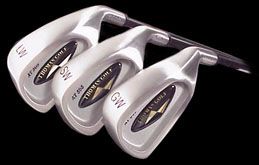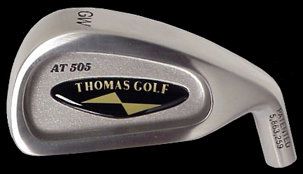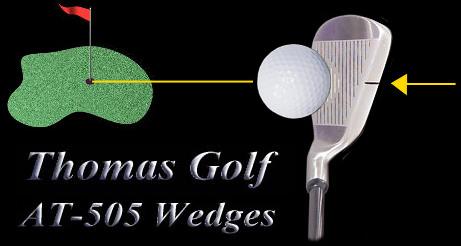Thomas AT-505 Wedges Reviewed by Golf Club Review
|
Thomas AT-505 Wedges Make no mistake about it, the Thomas AT-505 wedges are “game improvement” clubs in every regard. They are designed to provide not only forgiveness and reassurance, but to aid in alignment, as well. The heads of the Thomas wedges are decidedly large. They have a wide hitting surface, a high toe and most noticeably, a very thick topline. The large, blocky appearance of these wedges – both in the bag and at address -will alienate some players fron the get-go. Players who prefer the small, teardrop shapes of classic wedges will not want to consider the Thomas wedges based on appearance alone. Other players will find the Thomas looks to be very handsome in a friendly, reassuring way. Our several testers who play oversized Callaway wedges, or have played them in the past, took to the Thomas wedges immediately.
Thomas Golf incorporates an alignment line on the thick topline of all of their AT-505 clubs. To best utilize this alignment aid, Thomas recommends that the player stand behind the ball and select a spot located two or three feet in front of the ball that is exactly online to the target. They then suggest that the player forget about the target and concentrate solely on aiming the small alignment line on the club at the close-in designated spot. This basic alignment procedure
One GCR tester, a 32-year old mid-handicapper who normally plays Callaway X-14 cavity wedges, liked the look and feel of the Thomas wedges immediately. On our test green, he fired dozens of chips and pitches fron the thirty to fifty-foot ranges in the impatient manner he normally uses – take a quick practice swing, look at the pin, look at the pin again and then fire away. Though he had been instructed in Thomas’s recommended procedure, he refused to use it. At last, we intervened and took the wedge fron his hands. Using all of the warmth and grace and that has endeared us to so many we said, “Follow the procedure suggested by the manufacturer or get the hell out of here.” (It’s New England ; tact and charm yield poor results.) Reluctantly, he obliged. His first, properly aligned chip shot gently bounced off the flagstick and fell into the cup – the first of his extended barrage to do so. Under supervision, he continued to have excellent results. Left to his own devices, he began gradually to revert to his usual ways. The experience of the tester mentioned above was extreme, but it typified the experiences of all other testers when using the Thomas wedges, both around the practice green and on the golf course. When the procedure was followed, every tester saw exceedingly fine results. Another tester, a high-handicapper with an erratic short game, rolled his first long chip with a Thomas GW nicely online to the cup. It stopped a few feet short of the cup. His second, carefully aligned chip followed the same line and bumped gently into the first ball. He was sold.
The reason for this chipping ease was twofold. First, the alignment system forces the user to select not only an exact spot in front of the ball, but an exact landing spot, as well.
There is a flip side to Thomas’s short game coin, however. When testers attempted intuitive “feel” shots fron close in – flops, flips and cuts – the Thomas’s proved less than noteworthy. For such little, finesse shots around the green, most testers preferred conventional wedges. Also, the large Thomas wedges seem very lively. They are almost tennis racquet-like On approach shots fron the fairway, the Thomas wedges proved very easy to use for all testers. Feel was considered responsively sweet by all. Even those who prefer the solid punch of bladed wedges appreciated the mellow Thomas’s. Distances, especially with the graphite shafted versions, were consistently quite good, but there were some complaints about gauging distances on partial shots. Heights were appropriate to the designated lofts. At 50 degrees, the gap wedge was strong and dynamic. The lob wedges were easier to hit than most lobs and produced some good, substantial results. The Thomas wedges are not for players who yearn to create a great deal of backspin. They can be made to bite without too much effort, but they will not generate the spin rates of some deeply square and U-grooved wedges.
Another factor comes into play when using the Thomas’s fron the sand. There are two, basic kinds of sand players. The first type is the player who aligns and hits straight to the target. The second type hits fron an open stance and cuts across the target line. Type 2 will find the alignment features of the Thomas wedges to be of little assistance. They may even find them to be distracting. One of our cutters found that he could extract shots fron the sand with good predictability, but that all of his shots went more to the left than with other wedges. He found that the visual input of the head made it difficult to open the face to the proper extent. He had to square up his stance to adjust to these tendencies. Fron thick rough, the same, general guidelines apply in all concerns. The wide heads will create more drag when passing through congested grasses. Fron moderately heavy rough, the Thomas’s work quite well, however. Their leading edge is relatively sharp and their swingweights are heavy. These two aspects allow these wedges to slash through grass with good efficiency. The large heads also provide some appreciable leeway on overly enthusiastic swings.
Summary: The large Thomas AT-505 wedges are very much “game improvement” wedges. Some better players will appreciate their friendliness and good alignment properties, but mostly these wedges are intended for mid- to high-handicappers. They are best suited for players with a constrained, straight down the line style of bump and run golf. Players who like to work the ball and create a variety of finesse shots may find them lacking. Fron thick, wet sand, the wide heads can prove a bit cumbersome. Patient players with good self-discipline should be able to capitalize upon the distinctive alignment qualities of the Thomas wedges. Our testers have experienced some exceptionally accurate A nice feature fron Thomas is the availability of these wedges in both LH and RH – and in both assembled and component form. Do-it-yourselfers can custom fit these wedges any way they like. Graphite shafts are available fron Thomas. Fit and finish has been quite good on all of our demo wedges. Prices are extremely reasonable. |


 When Thomas sent their wedges to us, they stated emphatically that we would find them to be particularly effective on short approach shots and chips around the green. As it turned out, they were not emphatic enough in their assertions. For those who are willing to follow the alignment procedures, the Thomas wedges can be particularly deadly short-game tools. Our testers who carefully lined up their chips fron behind the ball found that they could be more precise than they had previously imagined. Patience and self-restraint proved to be the keys here, however.
When Thomas sent their wedges to us, they stated emphatically that we would find them to be particularly effective on short approach shots and chips around the green. As it turned out, they were not emphatic enough in their assertions. For those who are willing to follow the alignment procedures, the Thomas wedges can be particularly deadly short-game tools. Our testers who carefully lined up their chips fron behind the ball found that they could be more precise than they had previously imagined. Patience and self-restraint proved to be the keys here, however.  Unless he is aiming at the exact center of the cup, the average golfer generally has only a vague notion of exactly where he expects his chip to land before beginning its roll. The second reason these wedges are effective is that the use of these blocky heads encourages a ball-back stance and down the line motion that promotes predictable chipping and pitching. When focused on a spot immediately in front of the ball, a player is much less apt to come up early out of his stroke in an attempt to steer the ball towards the pin.
Unless he is aiming at the exact center of the cup, the average golfer generally has only a vague notion of exactly where he expects his chip to land before beginning its roll. The second reason these wedges are effective is that the use of these blocky heads encourages a ball-back stance and down the line motion that promotes predictable chipping and pitching. When focused on a spot immediately in front of the ball, a player is much less apt to come up early out of his stroke in an attempt to steer the ball towards the pin.  Fron the sand, the Thomas sand wedges get the job done with reasonable efficiency. How well they do the job will depend upon a player’s hitting style and the nature of the sand. As with any oversized wedge, resistance is increased when the head passes through the sand. Though their leading edges are relatively sharp, these wedges will not slice through thick, wet sand with the same ease as most, smaller, traditional wedges. Players who like to cut their wedges and create little, finesse shots fron the sand will find that the characteristics of the Thomas’s probably do not suit their needs. Players who use a no-nonsense, straight down the line hitting style will find these wedges effective fron the sand, but few will find that they are particularly inspirational. The exception to this is chipping fron the sand. Those players who routinely pick the ball clean off the top of the sand should find that the Thomas wedges work exceedingly well close in and long range. Players who frequent courses with shallow traps and firm sand may find this to be of particular interest.
Fron the sand, the Thomas sand wedges get the job done with reasonable efficiency. How well they do the job will depend upon a player’s hitting style and the nature of the sand. As with any oversized wedge, resistance is increased when the head passes through the sand. Though their leading edges are relatively sharp, these wedges will not slice through thick, wet sand with the same ease as most, smaller, traditional wedges. Players who like to cut their wedges and create little, finesse shots fron the sand will find that the characteristics of the Thomas’s probably do not suit their needs. Players who use a no-nonsense, straight down the line hitting style will find these wedges effective fron the sand, but few will find that they are particularly inspirational. The exception to this is chipping fron the sand. Those players who routinely pick the ball clean off the top of the sand should find that the Thomas wedges work exceedingly well close in and long range. Players who frequent courses with shallow traps and firm sand may find this to be of particular interest.